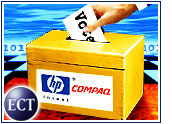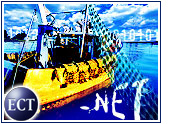
In Part 2 of this interview, Carat Interactive vice president and media director Mark Stephens talks with the E-Commerce Times about how new Internet ad sizes and formats will transform the industry.
Click here to return to Part 1.
ECT: What advantages have you gained through running abanner ad campaign?
Stephens: Banners work well in conjunction withother ads, depending on what you do within the banner. There are places for all sorts of ad sizes, depending on the aim of the campaign.
For example, we have used banner ads to trigger pop-unders. Point-roll technology also works great — where you canpull more information out of the banner, as Bluestreak isdoing. But these banners have to be extremelytargeted.
ECT: What advantages have you gained through marketingin e-mail newsletters?
Stephens: E-mail is so pervasive and is a big part ofopt-in marketing. The advantage of e-mail is it allowsyou to have that one-to-one relationship. It allowsyou to be very targeted because people requestinformation about specific items or categories. And itallows you to have a dialogue back and forth. You cankeep sending people information [or incentives], moving them closer topurchase. But we are big proponents of privacy andare anti-spam.
The industry is evolving at an incredibly rapid pace. The challenge is sifting through the vendors that are going through thatevolution.
Bigger Is Better
ECT: Have the new, larger ad sizes had an impact onyour advertising campaigns?
Stephens: We have utilized skyscrapers, pop-ups andpop-unders. It has allowed us to take a creative leapand make ads much more impactful. It has affected theresponse rate as well. Also, we have done researchwith clients, and there is not a lot of negativepushback about the pop-ups and pop-unders, as long asthey are targeted and the copy is not overly aggressive.
A lot of sites have reconfigured themselves. Many ofthe available units are page-dominant. My hope is thatby the end of this year or sometime next year, mostsites will standardize on those page-dominant units,and [smaller] banners will be on their way out.
The types of advertisers that are starting to come online — Fortune500 companies we work with at Carat — are notinterested in running a [simple] banner campaign. They wantsomething that has some impact and panache.
ECT: What are some successful strategies for onlineadvertising?
Stephens: Understand the target. You need tounderstand their habits online and overall. You needto deliver things that satisfy their needs.
Another key is always be mindful of your results. Make somepredictions beforehand. We even map out expectedresults from a brand perspective. The fact that thismedium is very accountable is a good thing.
Rising Tide
ECT: What pitfalls should an online advertiser try toavoid?
Stephens: Overhype and overpromising. You run intoproblems when something is completely new and you sellit as something that is going to work. Clients are atvarious stages of interactive advertising. Some arewilling to test and experiment, but we make it clearthat we are going into uncharted territory.
And scrutinize your vendors. At Carat, we have a rigidvendor qualification process.
ECT: Are there products or services that are notsuited for promotion through online advertising?
Stephens: I think the Internet will be appropriate forjust about everything, eventually. But there are a lot ofpackaged goods companies that are still trying tofigure out how to use the Internet. You are not goingto buy Tide online. It is not economically viable.
The challenge is evolving the branding side of thebusiness as well as integrating online with offline– such as getting a coupon online and redeeming it ata grocery store. Some packaged goods companies want tosee clear evidence that the Internet can brand.
ECT: How do you measure the effectiveness of anInternet marketing campaign? What factors come into play?
Stephens: It depends on what the objective is. If itis brand awareness, we will do a dynamic logic studyand look at awareness and purchase intent — how far we”moved the needle.” In other cases, there might havebeen some action we were looking for.
With Adobe, it might be product demonstration downloads. With Bank ofAmerica, it might be signing up for online banking.For some, it might be selling the product right away,like with Palm.
There are a number of different waysto look at the results. You can look at directclick-to-sale or view-through data, where they saw thead and went back to buy it later.
Future Perfect
ECT: Based on your experience with Web marketing thusfar, what does the future hold for online advertising– both in terms of strategy and technology trends?
Stephens: Eventually, there is going to be a fast pipeinto your household, and there is going to be a lot ofstuff going through it. Television is going to mergewith online, but we are still working that scenarioout. They are definitely going to grow closertogether. Over time, the Internet is going to becomeless computer-centric and more of an overall tool orappliance. Once media are more interconnected, it willmake doing business that much easier. Impulsepurchases could happen just like that.
And I believe over the next few years the Internet isgoing to be heavily regulated. Part of the challengeis to self-regulate and get things in order, becauseit will eventually be regulated by the government.
ECT: What advice do you have for a company starting toplan a new online advertising campaign?
Stephens: Keep an open mind. Do not put the Internetinto a single bucket. View it as equal to other media.In some cases, it may even be better, depending onhow much you are trying to do. Think about where yourtarget is and how you are going to reach them. Andthink about the follow-up step, not just theadvertising. Think about the customer relationship andhow you are going to facilitate that.


























































Social Media
See all Social Media